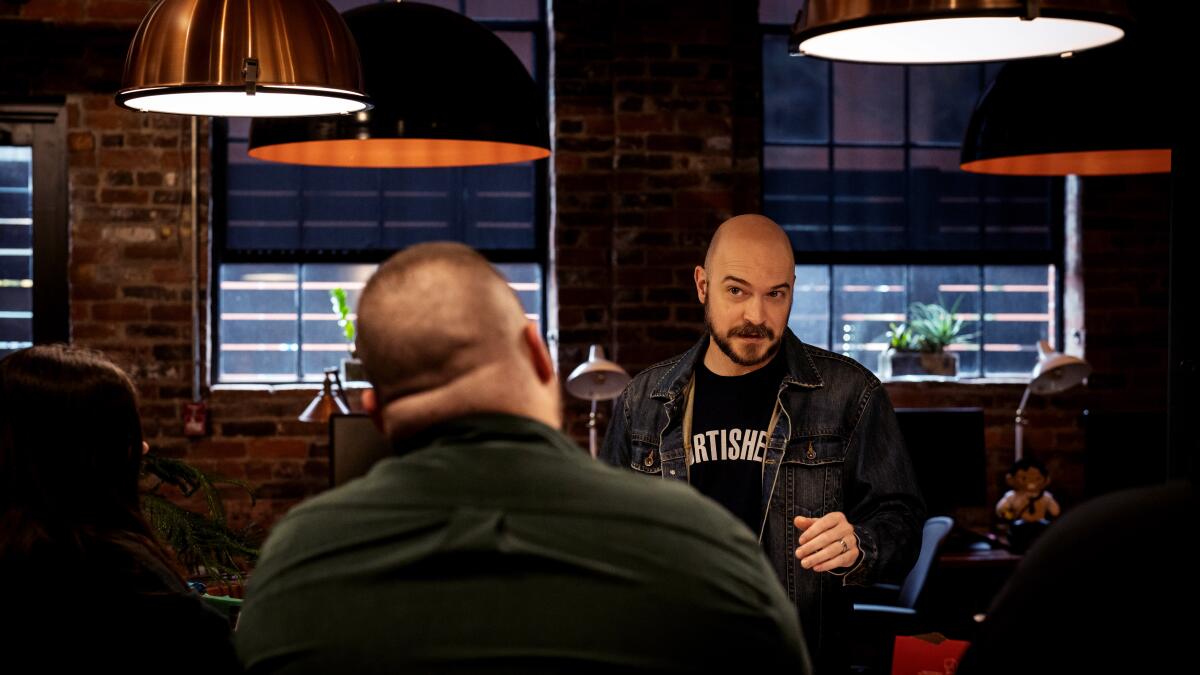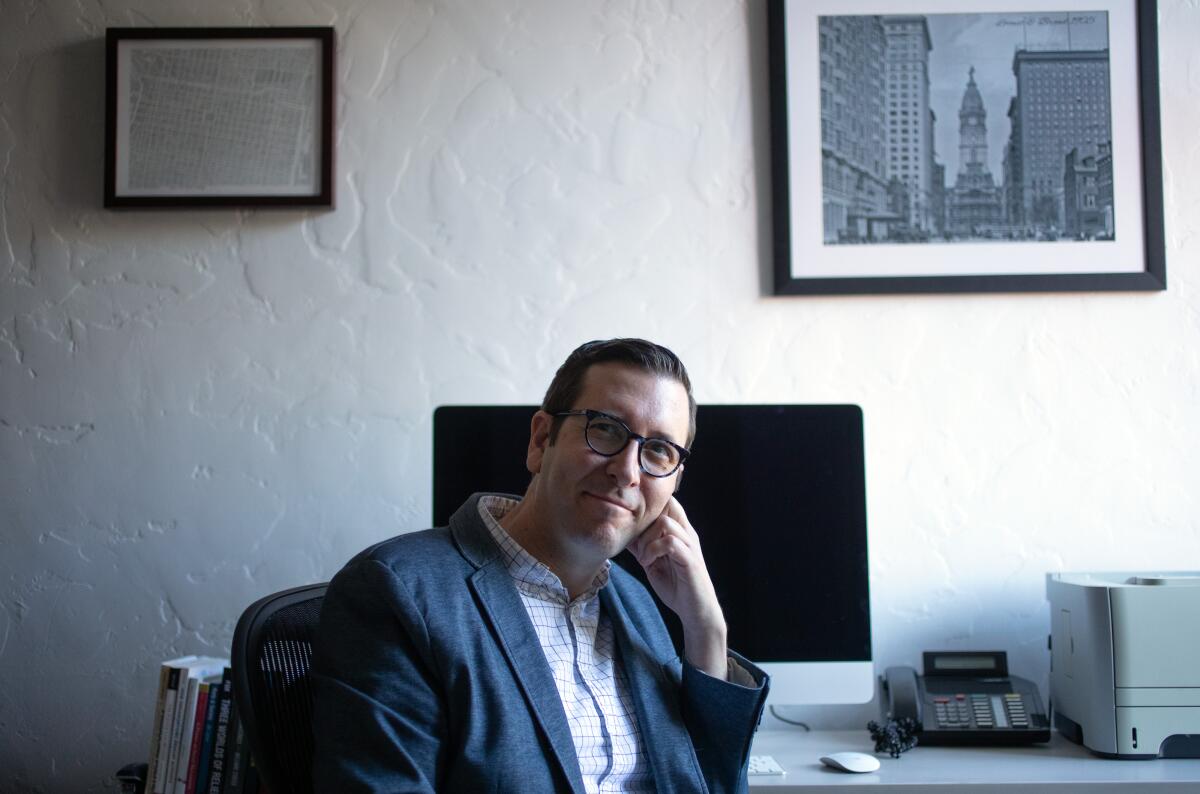A 32-hour workweek with 40-hour pay? It’s happening at some companies

- Share via
Video game makers in Kentucky are cranking four days a week on a new title based on the classic slasher movie “The Texas Chainsaw Massacre.”
The twist? Workers making the horror game are being paid the same salaries they used to get for working five days a week.
As disruptions to standard workplace practices caused by the pandemic continue to ripple through the economy, some companies are adopting 32-hour workweeks at formerly 40-hour pay, which effectively makes every Friday a paid holiday.
The shortened week has been a winner for Gun Interactive, Chief Executive Wes Keltner said, as employees stay focused to complete their tasks on time and return to the office on Monday with a full head of creative steam because they’ve had sufficient downtime.
“You have a finite well of creativity in your body. When it’s tapped, it’s tapped,” he said. “After that, you do subpar work.”
A four-day workweek at five-day pay sounds exotic because so far it is. Few companies have formally adopted the practice, but it’s on the menu for some as employers cast about for ways to set up hybrid work schedules that will appeal to pandemic-weary workers they want back in the office or, at least, fully engaged in their jobs.
Many white-collar companies are already partaking in what look like four-day weeks, even if bosses are expecting workers to put in 40 hours of work at times of their choosing. Fewer than 20% of U.S. workers come to the office on Fridays these days, said Mark Grinis, leader of EY’s real estate practice in the Americas. The weekly average is nearly 50%.
“You are already edging toward a vacancy on Fridays,” he said. “It’s not a big leap” to block them off the work calendar.
More than 20% of companies are already implementing some version of a four-day workweek, and an additional 46% are planning or considering the shorter week, EY reported after a November survey.
EY didn’t attempt to break out which companies are committed to 40-hour pay for 32 hours of work, and the number of such companies still appears to be small. But historic notions about how workers should perform their jobs have been upended before — and will be again.
The accepted number of hours people should work in a week has evolved over time, with factory laborers in the Industrial Revolution clocking as much as 100 hours a week. Henry Ford popularized the eight-hour day in the 1920s, but 40-hour weeks didn’t become the norm until the Great Depression, when the government saw shorter workweeks as a way to spread jobs among more people. That standard has stood strong for more than 80 years.
But the pandemic was a strikingly disruptive event that forced companies to find new paths to get their business done and tangibly demonstrated alternatives, workplace experts say.
COVID-19 supercharged use of technological advances made in recent decades that made it possible to work anywhere. Executives knew remote work was feasible, but the pandemic forced them to put it into practice at a wide scale.

Few workers want to go back to office practices built around landlines, typewriters and snail mail that chained people to their company workstations. As the World War I doughboy song goes: They have seen Par-ee and don’t wanna return to the family farm.
“We broke the mold on how it’s supposed to work,” Grinis said, “and we’re not going back.”
The government is unlikely to make four-day weeks a rule for employers any time soon. A bill that would have changed the definition of a workweek from 40 hours to 32 hours for companies with more than 500 employees stalled in the California Legislature last spring. People who worked more than 32 hours would have received overtime pay.
Opponents said a four-day workweek would stunt job growth in the state and could create untenable conditions for employers. The California Chamber of Commerce included the bill on its “job killer” list, writing that it would significantly increase labor costs, expose employers to litigation and impose requirements that would be “impossible to comply with.”
Employees at L’Oréal get concierge service, a vegetable garden and other perks as some bosses pull out the stops to get workers back to the office
National legislation introduced in Congress last year to mandate overtime after 32 hours of work also failed, but its sponsor, Rep. Mark Takano (D-Riverside), has vowed to try again.
“People continue to work longer hours while their pay remains stagnant,” he said in a statement. “We cannot continue to accept this as our reality.”
A recent pilot study of four-day workweeks for five-day pay unsurprisingly found that workers loved the concept, but also found that many bosses ended up on board too.
In the international study by New Zealand nonprofit 4 Day Week Global, 33 companies with nearly 1,000 workers agreed to a six-month tryout of shortened workweeks.
The study was done through an international collaboration with researchers at Boston College, University College Dublin and Cambridge University. Most of the study participants were in the U.S. and Ireland.
“The companies are extremely pleased with their performance, productivity and overall experience,” the report said. They reported that revenue rose over the course of the trial, sick days and absenteeism were down, and resignations fell slightly.
“Stress, burnout, fatigue, and work-family conflict all declined, while physical and mental health, positive affect, work-family and work-life balance, and satisfaction across multiple domains of life increased,” the report said.
None of the 27 companies that completed the final survey said they were leaning toward going back to five-day weeks and 18 said they would definitely continue their four-day schedules.
Identities of the participants were not revealed, but three small companies reached by The Times also said their experiments with four-day weeks were successful and that they won’t go back to five-day schedules.
“The benefits are significant,” Gun Interactive’s Keltner said. “I have yet to see a prominent con.”
Gun Interactive has been on the program since early 2021, he said. “We haven’t looked back since.”

Employees work together Monday through Thursday in their office in Lexington. Keltner acknowledges that there is “the occasional Friday when I need a couple of people, but it’s rarely a full day’s worth of work.”
Most Fridays he goes fishing or hiking to unwind, he said.
Young employees at design firm Halftone Digital in Minneapolis like to go out on Thursday nights because they have Fridays off, founder Michael Arney said.
Arney removed Fridays from the company workweek without reducing salaries early this year after he lost a designer to a firm that offered the employee a 50% raise.
“For me, that was really the straw because I thought to myself, I can’t afford to compete with that type of salary but what I can compete on is lifestyle and culture.”
His employees were at first subdued when he announced the four-day plan as an experiment. “I thought I would hear more cheering,” he said.
Perhaps they were waiting for another shoe to drop, he said, with employees wondering, “‘Is this for real or is it just lip service? Is it just 50% of the time?’ There were a lot of unknowns from folks.”
A growing number of Los Angeles-area office buildings are being converted to residential use as demand for offices stalls.
The company’s digital design business lends itself to remote work and flexible hours, he said, and it no longer has a physical office. Employees also get unlimited paid time off.
Clients sometimes give Arney some “jealous ribbing” about his company’s schedule, but “I have not heard or sensed any ill will” about Halftone Digital’s performance, he said.
Occasional hours on Fridays are required to meet client needs, but none of his eight employees have left since the policy was put in place, Arney said. He often spends his Fridays playing pickleball and lunching with his mother in her retirement home.
While shorter workweeks are being embraced by some companies, bucking the established 40-hour standard is not without peril, said Edward Walker, a sociology professor at UCLA.
“What if I’m the only company that does this when my competitors don’t?” he said. That could create a competitive disadvantage when most people live in the 40-hour world and expect to do business all week. How would customers respond, for instance, to learn the service desk they want to contact is closed Fridays?
Can employees really finish what needs to be done for the week in 32 hours, or would employers need to take on additional help or pay overtime, as Chamber of Commerce opponents fear, raising labor costs? What about startups that offer stock as “sweat equity” to employees in exchange for round-the-clock commitments?

There are many interlocking systems and expectations built around the 40-hour standard, Walker said, and changing the status quo might require the force of a labor movement.
For now, it’s pioneers such as Kale & Flax that are cutting workers’ hours without reducing their pay. The design company that helps clients launch new brands started working 32-hour weeks in 2018, when Creative Principal Tarik Nally was looking for ways to make his Louisville, Ky., business more competitive at attracting and retaining talent, he said.
Employees are on call Fridays to respond to client emergencies, but the need doesn’t arise often enough to diminish the benefits of more time off, he said.
“We give people 52 days back a year and maybe on six of those Fridays [employees] put in 45 minutes to help with a quick emergency.”
When company revenue fell during the pandemic, Kale & Flax contemplated working Fridays but stuck with four days and went on to recover financially. The trick is to stay focused every day, Nally said, even when you’re not feeling like it.
“There are days where I wish I could be lazy and then make it up on Friday.”
Since adopting the 32-hour week, though, “we’ve doubled in team size. We also doubled our revenue in the last three years.”
The company has 14 people and he is looking to hire two more, he said. “We’ve never had anyone we offered a job to decline.”
Time to unwind is more important to employee satisfaction than petty perks, he said.
“Are your perks a pingpong table and free beer? Or is it giving people the space to invest in themselves and their families?”
Americans’ relationships with their employment may be in flux, but the country’s long-standing work ethic finds virtue in plugging away as hard and as long as it takes to get the job done, said Roy Bahat, head of Bloomberg Beta, an early-stage venture firm backed by Bloomberg that invests in startups intended to make work better, and a lecturer at UC Berkeley.
“In America we associate value at work with intensity,” he said. “That can be confused with hours of work.”
And be rewarded too, he said. “Get in the office before everybody and leave after everybody else is a common piece of advice that you hear and the truth is it can work really well.”
But business owners are willing to try new ways of operating that wouldn’t have occurred to them before the pandemic, he said. “The genie is out of the bottle.”
Experimentation might slow next year if the economy slows, he said, but employers will keep trying new ways to achieve productivity outside the 40-hours-in-the-office template.
“Absolutely more companies are going to try 32-hour weeks because more companies are going to try lots of different things to see what works,” Bahat said. “I think the next 10 years are going to be years of trial and error.”
More to Read
Sign up for Essential California
The most important California stories and recommendations in your inbox every morning.
You may occasionally receive promotional content from the Los Angeles Times.













